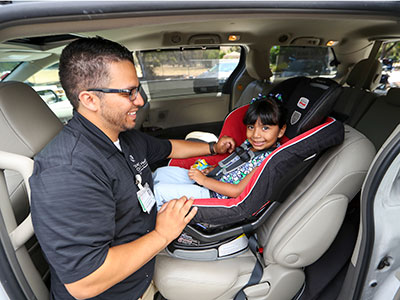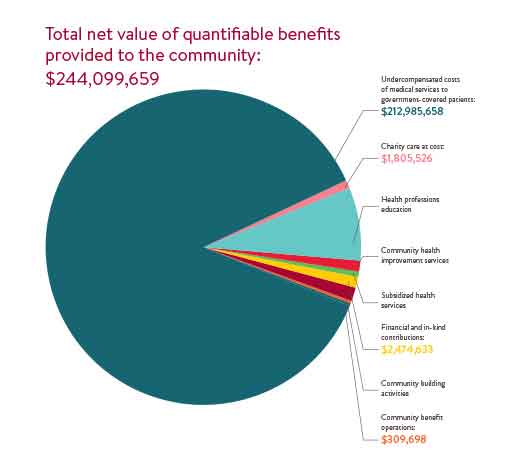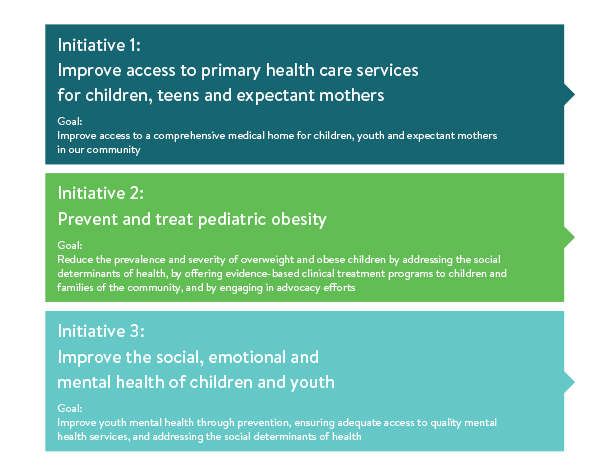Bay Area Community Nonprofit Support by Lucile Packard Children’s Hospital Stanford Reached $2.7 Million in 2018
Part of a robust community support program valued at $244M in 2018. Through a series of partnerships, programs and grant initiatives, the hospital continues to improve the health of children and expectant mothers in the Bay Area.
For release: April 30, 2019

STANFORD, Calif. – Even though Ravenswood Family Health Center is only 3 miles from Lucile Packard Children’s Hospital Stanford, it’s an insurmountable distance for many families. Without the nearby community health clinic, parents in the area would have to take multiple buses and spend more than an hour getting to the hospital for care.
“If we can keep kids from having to come to the hospital, that’s a great thing,” said Sherri Sager, chief government and community relations officer for Packard Children’s Hospital. “It’s part of the hospital’s DNA to improve the health of all children in the greater community, and one way we do that is by partnering with community clinics in order to provide care that’s close to home.”

| In fiscal year 2018, as a single hospital, Packard Children’s invested over $244 million to improve the health status of infants, children, adolescents and expectant mothers. The bulk of that investment provided for undercompensated care for Medi-Cal and other government funded patients. Additionally Packard Children's invested $31 million in the greater community through grant funding, donations and hospital-based programs. Direct support of local nonprofit organizations was upwards of $2.7 million. |
Sager explained that Packard Children’s investments in trusted community partners aim to expand access for families to receive care for their kids in their own neighborhoods. These include community-based health centers that serve as providers of comprehensive primary care services in a patient-centered environment, including Ravenswood in East Palo Alto; Santa Cruz Community Health Centers; MayView Community Health Center in Mountain View, Sunnyvale and Palo Alto; and Gardner Packard Children’s Health Center in Atherton.
Committed to improving the health of Bay Area communities
“We select organizations that have a proven track record of improving the health of some of our most vulnerable community members,” Sager said. “For more than 25 years, we’ve been committed to improving the health of Bay Area communities.”
In addition to supporting local health centers, Packard Children’s brings health care directly to underserved children at shelters and schools through hospital-based programs. The Mobile Adolescent Health Services program, also known as the Teen Van, provides free-of-charge multidisciplinary care to high-risk kids and young adults ages 10 to 25 in Santa Clara, San Mateo, and San Francisco counties. Many of the young people who rely on the Teen Van face difficult circumstances, including homelessness. In 2018 (fiscal year), 526 youths received ongoing, comprehensive services across 10 community sites that the van routinely visits.
Packard Children’s recently released the 2018 “Community Benefit Report,” which outlines community health improvement efforts that directly address needs established in the Community Health Needs Assessment (CHNA). CHNA takes the pulse of the region’s health every three years, turning data into actionable steps.
For 2017 to 2019, the hospital adopted three core health initiatives:

One community program in particular encompasses all three initiatives, creating a multidisciplinary hub for kids with complex health care and social support needs: Santa Cruz Community Health Centers. In 2017, Packard Children’s helped establish the Pediatric Complex Care program, giving the community access to specialists and subspecialists, and providing an integrated plan that provides wraparound care for kids. Besides medical care, the program delivers mental and behavioral health care while addressing the social determinants of health, including income level, housing security, and access to care. A pediatric case manager works closely with families and forms partnerships with providers, county resources and schools to give kids the best chance at success.
“In order to live healthy and prosperous lives, we need homes, neighborhoods, workplaces, schools and communities that positively affect the health of individuals—this is particularly important in a child’s first few years of life,” said Joseph Vaughan, manager of community partnerships at Packard Children’s.
Sager believes community investments deliver an extra punch when coupled with community partnerships and legislative advocacy. She explained that Packard Children’s gets “in the legislative trenches” to promote policies and social change to support the health needs of children and expectant mothers. In 2018, Packard Children’s invested close to $500,000 in advocacy efforts to ensure access to quality health care.
“As part of our advocacy efforts in 2018, we held our second adolescent mental wellness conference and brought five audiences—teens, educators, families, policy makers and clinicians—together to hear each other’s perspectives,” said Sager. “So much has grown out of that, including new state funding to support freestanding clinics that serve as one-stop shops for adolescents, providing mental and physical health care as well as substance abuse solutions and school support. We are planning in partnership with Santa Clara County to open the first two in the county this year.”
The “Community Benefit Report” delineates for community investments by type, including: community health improvement services ($3.1 million); community building activities ($3.8 million); health professions education ($18.2 million); charity care ($1.8 million); subsidized health services ($1.4 million); and financial and in-kind contributions and community benefits operations ($2.7 million).
The 2019 CHNA survey is underway, but Sager predicted it will likely reveal a repeat of the same needs as the 2017 survey: access to primary care, pediatric obesity and adolescent mental health. In the next three years, Packard Children’s will continue to focus on these core areas. However, according to Sager, it will reassess specific programs to ensure that its community health improvement strategy is working.
“We can’t do it by ourselves. We know it takes an entire community to move the needle on these complex health needs. That’s why we partner with others on a deep level and leverage our resources to make real impact in the communities we serve,” Sager concluded.
Media contact:
Kate DeTrempe
media@stanfordchildrens.org
(650) 721-8527
About Stanford Medicine Children's Health
Stanford Medicine Children’s Health, with Lucile Packard Children’s Hospital Stanford at its center, is the Bay Area’s largest health care system exclusively dedicated to children and expectant mothers. Our network of care includes more than 65 locations across Northern California and more than 85 locations in the U.S. Western region. Along with Stanford Health Care and the Stanford School of Medicine, we are part of Stanford Medicine, an ecosystem harnessing the potential of biomedicine through collaborative research, education, and clinical care to improve health outcomes around the world. We are a nonprofit organization committed to supporting the community through meaningful outreach programs and services and providing necessary medical care to families, regardless of their ability to pay. Discover more at stanfordchildrens.org.
Connect with us:
Download our App: